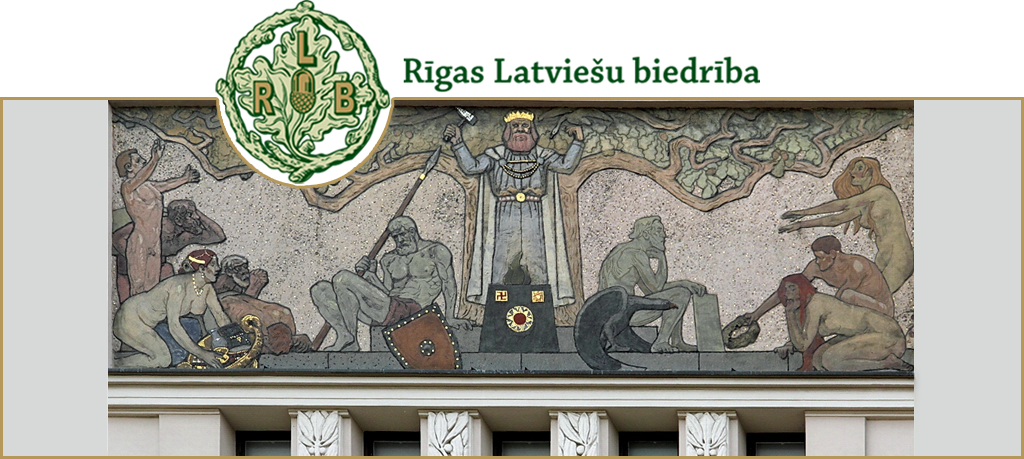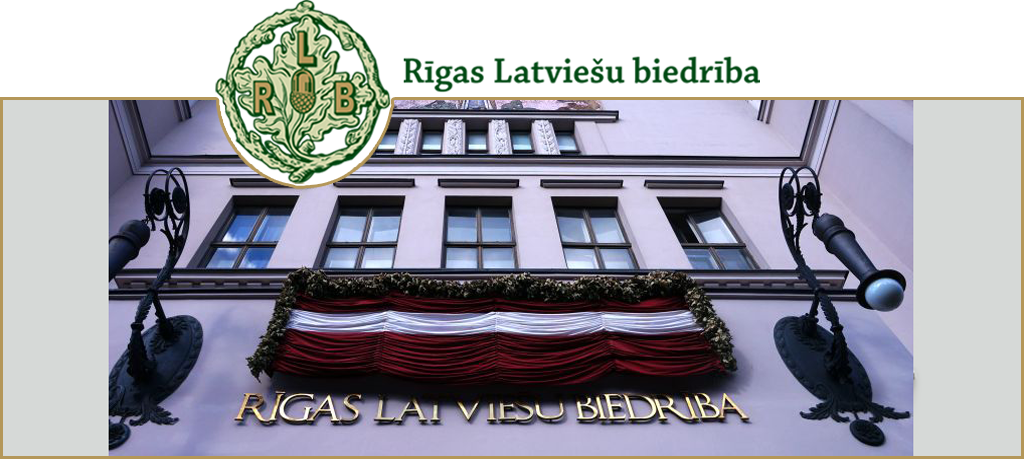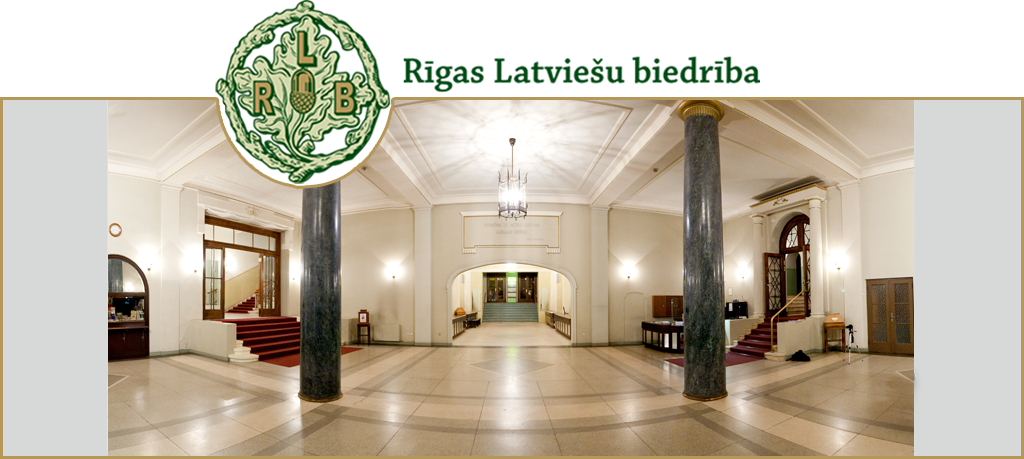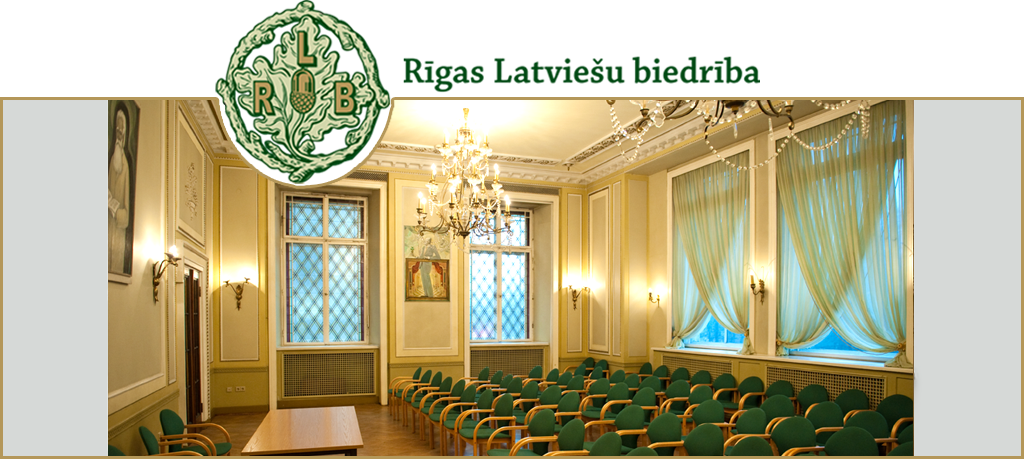



Riga Latvian Society STATUTES from March 5, 2011
RIGA LATVIAN SOCIETY STATUTES
Chapter 1 NAME OF THE SOCIETY
1.1. Name of the society is “Riga Latvian Society” (hereafter in the text – Society).
1.2. The abbreviation of the Society is “RLS”
Chapter 2 GENERAL TERMS
2.1. Society that has been founded in 1868 and whose activities have been restored on January 14, 1989, is a voluntary, independent non-governmental cultural organization.
2.2. Society works in accordance with the laws of the Republic of Latvia and the statutes that are based on the statutes Nr. 18467 registered on April 26, 1938 in Ministry of Social Affairs.
2.3. Society is a juridical organ with its statutes registered as stated by the law, with its seal with an inscription “Riga Latvian Society”, with independent balance, ots own bank account, movable and real property.
2.4. Society’s legal address is Meríeďa Street 13, Riga.
2.5. Society has its own flag and logo that is approved by the General Meeting of the society members and that is made and used in accordance with the Society’s council regulations.
2.6. Society has been founded for indefinite time.
Chapter 3 AIMS OF THE SOCIETY
3.1. Aims of the Society are:
3.1.1. to keep and maintain Latvian culture, language, Latvian traditions, national identity and Latvian lifestyle;
3.1.2. to promote strengthening of Latvian national belonging and awareness;
3.1.3. to promote development of education, science, art and literature;
3.1.4. to participate actively in Latvian nature’s and cultural monuments’ protection and care activities and nation’s cultural life’s activities, participate in making of Latvian environment, nation’s education and organizing creative projects;
3.1.5. to enact non-formal educational programmes, interests education, lifelong education, further education courses and project work;
3.1.6. to gather information about Latvians all over the world, cooperate with them, find out and promote their achievements in economy, science and culture and take care of maintenance and use of these achievements in Latvia;
3.1.7. to promote unity of Latvians all over the world;
3.1.8. to show the place of Riga and Latvia in world context.
3.2. To achieve its aims the Society:
3.2.1. organizes meetings, lectures, conferences, concerts, different performances, social evenings, exhibitions and competitions;
3.2.2. publishes and distributes books, magazines, newspapers and other printed materials;
2.3. celebrates national holidays, organizes events connected with national traditions, remarkable social, science and culture workers’ jubilees and other events;
3.2.4. participates in development and realisation of event projects connected with folk traditions and other kinds of events;
3.2.5. supports activities and formation of different amateur and professional groups;
3.2.6. keeps own library and makes own archive;
3.2.7. allocates different awards and benefits for the promotion of Society’s aims;
3.2.8. develops economic activities, and uses income to reach the aims stated in the statutes;
3.2.9. does any other activities to reach aims stated in the statutes if they are not in conflict with the laws of the Republic of Latvia.
Chapter 4 SOCIETY’S MEMBERS, PROCEDURE OF THEIR AFFILIATION, DISSOLVING AND EXCLUSION
4.1. The Society has its real members, Lifelong Members and Honorary Members.
4.2. Real member of the Society can be capacitated adult persons who have handed in written application form, promising to fulfil Society’s statutes and actively work to achieve its aims. The application form is appointed by the Society’s Council.
4.3. The person becomes a real member when the Society’s Statutes’ and Ethics’ Commission has considered his/her candidacy and the Society’s Council affiliates the person.
4.4. If the applicant is not affiliated, the Council has to declare its motivated decision in written form. The candidate can appeal the decision in written form to the General Meeting of the members whose decision is final. Repeated application form the candidate can hand in not earlier than a year after the decision.
4.5. Society’s Lifelong Members can be persons who have been the members running for 25 (twenty five) years and declare to the Council their wish to be a lifelong members.
4.6. Society’s Honorary members, after the Council’s suggestion, are outstanding art, culture and science personalities or persons who have great merits in enactment of the Society’s aims. Society’s Honorary members are elected for life. Honorary member can be a person who has gained not less votes than 2/3 (two thirds) of the present members of the General Meeting.
4.7. Status of the Society’s member acknowledges the membership card.
4.8. The members withdraw the Society at will, announcing about such decision in written form to the Council.
4.9. With the decision of the Council, rights of a member can be in abeyance until 6 (six) months or the member can be removed from membership of the Society if he:
4.9.1. does not pay the membership fee without justified reasons;
4.9.2. does not fulfil requirements of the statutes, member’s duties, does not participate in events organized by the Society or in other kinds of activities;
4.9.3.with his activities detrimentals Society’s honour or delays the implementation of the aims stated in the statutes;
4.9.4. acts in the name of the Society without special authorization.
4.10. Decision about the exclusion of the member the Council receives with the majority of votes. The decision of the Council about exclusion can be appealed to the General Meeting of the members whose decision is final.
Chapter 5 MEMBERS’ RIGHTS AND DUTIES
5.1. The real members of the Society have rights to:
5.1.1. vote and be elected in the Society’s and its structural governing bodies;
5.1.2. act in the Society’s structures and participate in their organized events;
5.1.3. discuss the work of the Society’s structures and their organized events;
5.1.4. be present in the Society’s structures’ and Council’s meetings and express one’s opinion about the questions reviewed in these meetings.
5.2. The real members have duties to:
5.2.1. work actively to gain Society’s aims, by participating directly in the activities or with one’s activities support and promote the realization of these aims;
5.2.2. participate in the Society’s General Meeting’s work;
5.2.3. consistently observe Society’s statutes, Council’s and Board’s decisions;
5.2.4. with one’s activities raise Society’s prestige, reserving everything that can harm Society’s reputation.
5.3. Society’s Lifelong members and Honorary members have all the real members’ rights.
5.4. Society’s real members pay the General Meeting’s stated entrance fee and membership fee. Lifelong members and Honorary members are free from payment.
Chapter 6 SOCIETY’S BRANCHES
6.1. With the decision of the Council can be created Society’s commissions, clubs, councils, interest groups, national applied arts studios, artistic groups and other branches.
6.2. Branche’s work, rights and duties, as well as relations with the Society, regulates Branch rule affirmed by the Society’s Council.
Chapter 7 ADMINISTRATION
The General Meeting of the members
7.1. The Society’s higher decision-making body is the Society’s members’ meeting – General Meeting. General Meetings are regular and extraordinary. Regular General Meetings are called together once a year in February.
7.2. General Meeting:
7.2.1. makes decisions about Society’s statutes and the programme and introduces their changes;
7.2.2. elects 36 (thirty six) Council’s and 5 (five) Inspection Commissions members to three years;
7.2.3. listens to, evaluates and affirms Society’s Chairman’s and Inspection’s Commission’s overviews;
7.2.4. discusses and decides Society’s work’s main questions;
7.2.5. decides about the obtaining, pledging and expropriating of the immovable property;
7.2.6. after the suggestion of the Council elects Society’s Honorary members;
7.2.7. decides any other question connected with the Society’s work that is not in conflict with the laws of the Republic of Latvia and these statutes.
7.3. General Meeting calls the Board; its place, time and agenda is announced to the members at least two weeks before the stated General Meeting’s date.
7.4. Extraordinary General Meeting is called in three weeks time after the Board’s decision, or, if it is demanded in written form, by the, at least 1/10 (one tenth) of the members, giving the argument for it.
7.5. General Meeting is empowered to make decisions, if there participate at least 1/3 (one third) of the members.
7.6. If the General Meeting is not empowered to make decisions because of the lack of the quorum, in three weeks time is called recurrent General Meeting that is empowered to make decisions irrespective of the number of the present members, with condition that participates at least two members.
7.7. The decision of the General Meeting is made if more than a half of the present members vote for it. The decision about the stopping of the Society’s work is made, if 9/10 (nine tenths) of the present members vote for it.
The Council
7.8. The Society’s decision making institution between general meetings is Council. Its meetings take place in the stated times by the Council’s decision.
7.9. The Council:
7.9.1. elects from among the members to Council’s powers time Society’s Chairman and Vice-chairman, who both are the members of the Board, and elects 5 (five) more Board members;
7.9.2. brings forward the questions that should be discussed during General Meeting;
7.9.3. affirms Society’s annual budget;
7.9.4. in case of need makes budget corrections during the quarters;
7.9.5. organizes implementation of the aims stated in the statutes and accomplishment of the General Meeting’s decisions;
7.9.6. listens to, evaluates and affirms Society’s Chairman’s, Board’s and Society’s branches’ leaders’ reports;
7.9.7. makes work groups, expert commissions and other structures to do definite tasks and makes decisions about their work;
9.8. makes decisions about the establishing of the Society’s enterprise or company and presents the decision for approval to the current General Meeting;
7.9.9. within the framework of the budget makes decisions about Society’s property, possessions and resources usage principles and give corresponding instructions to the Board;
7.9.10. affirms Society’s staff employees and their salaries;
7.9.11. suggests to the General Meeting Honorary members’ candidatures;
7.9.12. affiliates and excludes Society’s members;
7.9.13. decides other questions connected with Society’s work, except those that are General Meeting’s competence.
7.10. Extraordinary meeting in 10 (ten) days’ time is organized at the Society’s Chairman’s, 1/3 (one third) of Council’s members’ or Auditing commission’s demand; meeting’s time and agenda is announced to the Council’s members at least 6 (six) days before the meeting.
7.11. The Council has rights to make decisions if there are present at least half of the Council’s members in the meeting, including Society’s Chairman or the Vice-chairman.
7.12. The Council makes decisions with the majority of votes. If the number of votes divides in similar parts, the decisive is the meeting’s chairman’s vote.
7.13. The Council has rights to vote for the replacement of its member who has discontinued his/her membership or has not, without any justified reason, attended 3 (three) meetings one by one, from the list of the candidates brought forward in the previous General Meeting of the members.
7.14. The Society’s elected official cannot be Society’s staff employee.
The Chairman
7.15. The Council’s work leads the Society’s Chairman who:
7.15.1. represents the Society in state and local government institutions, also in the court;
7.15.2. represents the Society in relations with other organizations and persons or instruct other Council members to make these duties;
7.15.3. in accordance with the procedure laid down in paragraph 8 of 8 concludes the contracts with juridical and physical persons or instruct to do it to the person authorised by the Council;
7.15.4. calls together and leads Council’s and Board’s meetings or instructs to do it to the Vice-chairman;
7.15.5. regularly informs the Council about the Board’s work;
7.15.6. employs and exempts the employees.
Chapter 8 EXECUTIVE BODY
8.1. The Society’s executive body is the Board that consists of seven Board members.
8.2. The Board’s work is organized by the Society’s Chairman.
8.3. The Board:
8.3.1. Calls General Meeting of the members;
8.3.2. Ensures the implementation of the aims stated in the statutes, accomplishment of the General Meeting’s and Council’s decisions;
8.3.3. Answers for Society’s economic activities and for the appropriate accounting complying with the law;
8.3.4. Administers Society’s property and acts with its means according to the law, Society’s statutes, General Meeting’s and Council’s decisions;
8.3.5. Decides questions about the concluding of contracts in the name of the Society, except those questions that are in the area of responsibility of the General Meeting and Council, pursuant to the procedure laid down in paragraph 8 of 8 of the statutes and the required representation level;
8.3.6. Decides questions about employing and exempting of the employees or ask to do it the Society’s Chairman;
8.3.7. Reports regularly on the accomplished and planned works to the Council;
8.3.8. Decides about the placement of the Society’s structural units in the Society’s house premises;
8.3.9. Deals with issues that are not in the area of responsibility of the General Meeting or Council;
8.4. The Board is entitled to decide if in the meeting are present more than half of the Board’s members, in the presence of Society’s Chairman or Vice-chairman.
8.5. The Board makes decisions by a majority of the members present. Where votes evenly divided, the casting is the meeting’s driver's vote.
8.6. The meeting’s protocol shall be signed by all the members of the Board.
8.7. The member of the Board can be cancelled before the deadline if such action has compelling reasons. The important reason can be the Board member’s action if it is contrary to the Society’s statutes, if he/she is not able to manage the Society, has harmed Society’s interests, as well as has lost the confidence.
8.8. The Chairman of the Society and the Vice-chairman represent the Society individually. Other members of the Board represent the Society together with other 4 (four) Board members. For the disposal or pledge of the real estate the Board has to require the prior approval of the General Meeting. For the deal, which binds the Society to make the payment, which amount is exceeding ten thousand lats, the Board has to require the prior agreement of the Council.
8.9. The member of the Board cannot be Society’s long term lease-holder.
Chapter 9 THE AUDIT COMMISSION
9.1. The Society’s economic and financial performance audit institution is the Audit Commission that consists of 5 (five) people.
9.2. The commission is elected from the Society’s members by the General Meeting.
9.3. The Audit Commission elects from among its members a chairman and secretary.
9.4. The Audit Commission is entitled to decide if the meeting involves more than half of the members of the commission, in the presence of the commission’s chairman.
9.5. The Audit Commission makes decisions by a majority of votes of the members present.
9.6. The Commission carries out the actions of the Society’s financial and economic control within the time limits laid down by the General Meeting, but not less than once a year.
9.7. The Audit Commission:
9.7.1. Performs the audit of the Society’s property and financial resources;
9.7.2. Delivers its opinion on the budget and the annual report;
9.7.3. Evaluates Society’s accounting and secretarial work;
9.7.4. Gives recommendations on the improvement of the financial and economic activities.
9.8. Members of the Society’s Council and Board cannot be the members of the Audit Commission. The Audit Commission is responsible only to the General Meeting.
Chapter 10 SOCIETY’S PROPERTY, FINANCIAL RESOURCES AND THEIR UTULIZATION SCHEME
10.1. The Society has its movable and immovable property and financial resources.
10.2. The Society’s financial resources are composed of:
10.2.1. The affiliation fees and membership fees; their amount is determined by the General Meeting. The affiliation fee of a new member is in the amount of a year membership fee regardless of the month of the joining the Society;
10.2.2. State and local government contributions, legal and natural persons’ donations with an indication of the use or without it;
10.2.3. Means earned in projects;
10.2.4. The revenue from events, trade with Society's attributes, printed matters, economic activities and other measures, as well as the use of the real estate.
10.3. The financial resources in accordance with the approved budget are used for:
10.3.1. The implementation of Society’s aims;
10.3.2. Providing of Society’s economic activities.
Chapter 11 SOCIETY’S LIQUIDATION
11.1. The Society can be liquidated by the decision of the General Meeting by the affirmative vote of at least 9/10 (nine tenths) of the members present.
11.2. If the General Meeting votes for theSociety’s liquidation, the General Meeting elects special liquidations commission of 7 (seven) till 9 (nine) people. The General Meeting determines the legal persons who have rights to receive the remaining Society’s property.
11.3. After the work completed by the liquidation commission it calls the General Meeting, where the commission reports on the results of the work of the liquidation.
11.4. On this latter decision of the General Meeting the liquidation commission reports to the national authorities in accordance with the provisions of the Law of Societies and Foundations.
The new version of the statutes accepted
During repeated Riga Latvian Society’s General Meeting
In Riga on March 5, 2011.